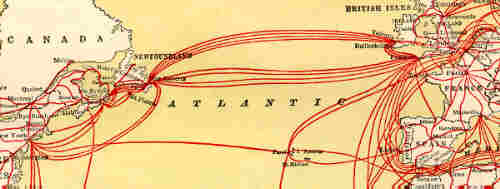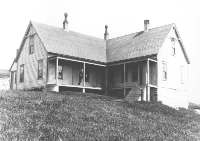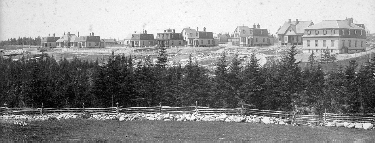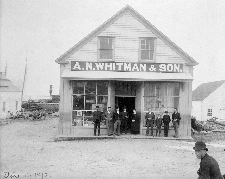Transatlantic Cable Communications
Canso & Hazel Hill
The Cable Story in Canso
To understand why the cables came into Canso, and why our area was of such strategic importance, we should take a look at some earlier developments.
The company that first established the cable link between Ireland and Newfoundland had been granted a special charter giving them exclusive landing rights for any cables to Newfoundland or Labrador for a period of fifty years. With the completion of the Transatlantic cable in 1866 it became evident to other business people that this new communications link could be put to good advantage; for example, the selling of news stories. In addition, the fees for sending messages across the Atlantic made it a profitable venture, so many others were determined to cash in on this new opportunity.
These other companies would not have been allowed access to Newfoundland or Labrador to land their cables, so naturally they would have looked to the next nearest point to Ireland in North America...which was the Canso area. Consider also, the reality that a message sent from Ireland to New York would be transmitted by cable to Heart's Content Nfld., then on overland telegraph to Cape Ray Nfld., by cable to North Sydney N.S. and then by telegraph to New York. This method would be more prone to errors being made in the message along the way as it was transferred from one line to another.
With steady improvements being made in the construction of submarine cables it would become possible to span the distance from Ireland to the Canso area, and at the same time install a direct cable link with New York. The advantages of a cable link between Europe and North America with only one relay station along the way were phenomenal.

Three Cable Companies in Guysborough County, Nova Scotia
In 1874, the Direct United States Cable Company landed at Tor Bay, Guysborough County, Nova Scotia. Known as the Faraday Station, and only thirty miles or so from Canso, it operated until 1887. The Western Union Company located a cable station in the town of Canso in 1881. In 1884, the newly created Commercial Cable Company established its relay station for transatlantic traffic in Hazel Hill, just two miles outside Canso. Many of the operators from Tor Bay ended up working for both Western Union and Commercial Cable. It appears that at that time the services of these cable operators was very much in demand.
 The Western Union Telegraph Company began in 1856 and grew quickly. In 1866, it expanded by purchasing the American Telegraph Company which had leases on most of the land lines in
North America and also had an interest in the construction of a cable across the Atlantic. The first cable into Canso was landed on May 23, 1881. The cable office was located at the base of Norris' Hill, and today the building is used as the Town's Administration Office. Housing for the employees was constructed at two locations, near the harbour and on School Street. The first superintendent was C.B. Dunham and there were up to forty members on staff. For several years the staff had been moved to Sydney where the company had landed some of its cables, but the Canso office was once again open and in 1923 the company constructed twelve new homes in Canso for its operators and created a very distinctive streetscape on Carlton Terrace, overlooking the town. Western Union left Canso permanently in 1955.
The Western Union Telegraph Company began in 1856 and grew quickly. In 1866, it expanded by purchasing the American Telegraph Company which had leases on most of the land lines in
North America and also had an interest in the construction of a cable across the Atlantic. The first cable into Canso was landed on May 23, 1881. The cable office was located at the base of Norris' Hill, and today the building is used as the Town's Administration Office. Housing for the employees was constructed at two locations, near the harbour and on School Street. The first superintendent was C.B. Dunham and there were up to forty members on staff. For several years the staff had been moved to Sydney where the company had landed some of its cables, but the Canso office was once again open and in 1923 the company constructed twelve new homes in Canso for its operators and created a very distinctive streetscape on Carlton Terrace, overlooking the town. Western Union left Canso permanently in 1955.
 Commercial Cable was the new kid on the block and it didn't take long for them to establish themselves as major players in the cable business. J.W. MacKay and J. Gordon Bennett had formed a partnership and
in 1884 the Commercial Cable Company had established its office at Hazel Hill. For this period in time the homes and facilities that were provided for the employees of the Cable Company were second to none. There were over twenty family homes constructed and a bachelors' residence along with a clubhouse. The properties were very well maintained by the company and plenty of activities and sporting events were organized by the Staff Athletic Association. At its peak of operations, shortly after the turn of the century, Commercial employed about 75 people. The company's influence on Canso was felt for seventy-seven years and when you consider that this spanned over four generations you get some idea of the number of people who had been involved in this story. Commercial Cable ceased operations in 1962 when Mr. Charles L. Holness sent the final message over the cable and turned the station off.
Commercial Cable was the new kid on the block and it didn't take long for them to establish themselves as major players in the cable business. J.W. MacKay and J. Gordon Bennett had formed a partnership and
in 1884 the Commercial Cable Company had established its office at Hazel Hill. For this period in time the homes and facilities that were provided for the employees of the Cable Company were second to none. There were over twenty family homes constructed and a bachelors' residence along with a clubhouse. The properties were very well maintained by the company and plenty of activities and sporting events were organized by the Staff Athletic Association. At its peak of operations, shortly after the turn of the century, Commercial employed about 75 people. The company's influence on Canso was felt for seventy-seven years and when you consider that this spanned over four generations you get some idea of the number of people who had been involved in this story. Commercial Cable ceased operations in 1962 when Mr. Charles L. Holness sent the final message over the cable and turned the station off.
The People, Homes and Lifestyles of the Cable Companies
The question may be asked, what effect did these companies have on the communities of Canso and Hazel Hill? The influx of some one hundred employees of the cable companies along with their families, to a coastal community that was successful in its own right with a lucrative fishery and supply businesses, only served to help expand the local economy. Their presence added much to the commerce of the town, exposed its residents to additional outside influences and created substantial growth.
In 1881, the Western Union Cable Office in Canso was situated at the edge of the town on the brow of Norris' Hill. This contributed to more development of the town in the area most have come to recognize as modern day Canso. There is a lack of documents with regard to early structures owned or built by Western Union as the old Schoolhouse and Town Office burnt to the ground in 1944, destroying all public records up to that date. However, it is safe to rely on old newspapers and accounts of the time which indicated the company had a long, two story building at the foot of Norris' Hill, which provided accommodation for families of the cable operators. The former Hospital and Convent buildings in town had been built by Western Union and used for their bachelor employees.![[tennis courts in Canso] /></CENTER>
</p><p>As was mentioned earlier, the Western Union for a time left Canso for Sydney with only one technician left behind to maintain the lines. This situation did not continue for long and in 1923 a major expansion was undertaken by the company and twelve fine new homes were constructed, eleven on Carleton Terrace, and a Superintendent's home across the street from the cable office. These large two and one half story homes were all built from the same plans with the exception of the Superintendent's home, which was larger and included a garage. Seven homes were on the east side of the Terrace with four facing them on the west side. An older structure called the Sailor's Rest was relocated from Union Street overlooking the water, to an area at the back of Carleton Terrace and used by the employees as a clubhouse. Recreation was available to the Western Union staff: a curling rink was in operation in the winter months, and tennis courts were located in the same area. Curling bonspiels and tennis matches were quite common between the employees of the two cable companies.
</p><p><img src=ccstaff.gif hspace=10 align=left alt=](tencrt.gif)
Out in Hazel Hill, Commercial Cable had created a community to surround its business. It seemed as if no expense was spared in making their staff members comfortable and well provided for. It is said that California gold financed the Commercial Cable Company and that after its station's construction in 1884, made the Canso area the major cable terminal in North America. For seventy-seven years from 1884 until 1962 the cables in and out of 'CS' (as the station was called), hummed and pulsed with the fresh news of two continents, twenty-four hours per day, every day of the week and year. An article in the Canso News of 1911 written by John A. Morrison gives an eloquent description of the effect of the Transatlantic cable on Canso and the world:
 Of the Cable service at large, the seven seas have been crossed and the whole world bound by these submerged chains. Wherever a flag flies, or a ship penetrates, you will find this great electric agency flashing
out its messages, from island to island and continent to continent. What a wealth of thought this mysterious factor conjures up? What poetry, what drama, is conveyed in these submerged links. A great event occurs, the news is flashed around the world, and in the space of time one would walk from Hazel Hill to Canso, the event is being discussed in the streets of London, or the business places of San Fransisco, in the bazaars of Bombay or at Whitman's store in Canso, and in the same instant of time every human heart is quivering with the shock. Franklin of Boston harnessed the lightnings, Cyrus W. Field plunged them under the sea and S.G. Brown spliced them in Dover Bay, Nova Scotia.
Of the Cable service at large, the seven seas have been crossed and the whole world bound by these submerged chains. Wherever a flag flies, or a ship penetrates, you will find this great electric agency flashing
out its messages, from island to island and continent to continent. What a wealth of thought this mysterious factor conjures up? What poetry, what drama, is conveyed in these submerged links. A great event occurs, the news is flashed around the world, and in the space of time one would walk from Hazel Hill to Canso, the event is being discussed in the streets of London, or the business places of San Fransisco, in the bazaars of Bombay or at Whitman's store in Canso, and in the same instant of time every human heart is quivering with the shock. Franklin of Boston harnessed the lightnings, Cyrus W. Field plunged them under the sea and S.G. Brown spliced them in Dover Bay, Nova Scotia.
In 1927, Charles Bellamy, the superintendent of Commercial Cable wrote a detailed article about the Hazel Hill station and about its people. He gives some rare insights into life during that time some seventy years ago.
The story makes for some very interesting reading and was uncovered and published in Forbes Magazine in 1987. Interestingly enough, mention was made in one of Mr. S.S. Dickenson's letters of the experiments of a Mr. Guglielmo Marconi and his attempts at wireless communication. There is a Marconi National Historic Site located in Cape Breton, Nova Scotia.
There were many key individuals involved in the Cable Story over the years. Two of these people were Mr. William Walsh and Mr. Frederick Creed. Neither of these men were famous to any recognizable degree, but they contributed very significantly to the companies that employed them.
- William Walsh was born in Canso and was employed as the pilot aboard the Cable Ship Faraday.
- Frederick Creed came to Canso at an early age with his parents and worked for some years at Western Union. He patented the Creed Automatic Printing System, or Teletype.
Another story of note, because of its impact on the world at the time, was news of the Titanic and its tragic fate. Mr. Bill Windeler was the first at the Commercial Cable office at Hazel Hill to hear the news of her distress.
Power Sources:
![[Canso Power Plant] align=left /> For messages to be sent over the cables it was necessary to have some source of power, so naturally we quickly think of our modern day electricity and how it provides us with a convenient source of power at our fingertips. Now, stop for a moment and consider that the large scale generation of electricity didn't take place until at least 1915. When the local cable companies first began transmitting over their lines, the battery was their source of electricity. Banks of batteries were in use in the transmission of messages over the lines until another source of electrical power became available. At Hazel Hill an electric power plant was in operation on the back lake in 1912, and a power plant was established in Canso in 1914. These plants were established much earlier than in other parts of the province.
</p><h2>The War Years</h2>
<CENTER><img src=hhww1.gif alt=](power.gif)
At the outset of the First World War, troops were dispatched to the cable stations at both Canso and Hazel Hill. The fact that the cables themselves were the only real link between Britain, Canada and the United States, was of prime importance. The troops that were stationed here were eventually set up in barracks, but for much of their time they remained housed in tents on property surrounding the cable offices. Sentries were on guard constantly and all persons moving in or out of the offices were questioned and searched if necessary. This precaution was not only applied to the people around the cable stations, there was a censor on duty at all times checking on the content of cable messages travelling to and from Europe in search of any subversive information. There are many people still living in the area that have recollections of the war years, when they were much younger. We only wish we could get some of them to put their stories into writing and share them with all of us.
Time marches on
The story of transatlantic cables here in Canso is an incredible one that can spark the imagination and generate many questions. There is a wealth of information on this history in our area and the Whitman House Museum in Canso, Nova Scotia is an excellent repository for much of this information. There are still many, many people who live in the area whose parents or relatives worked for the cable companies or for their employees. All of them have stories to tell and it would be a great loss if more effort wasn't put forth in bringing this information forward and expanding on the story of the "Original Information Highway".
As with all stories, this one must draw to a close. After much reading and research, the words of the last superintendent of Commercial Cable, Mr. Charles Holness, seem to best sum up the feelings at the time of the closing of the Hazel Hill station in 1962.
Some think that the closing down of Hazel Hill was the rather sad, quiet end of cable operations in Canada, but that is not the case. Cable is still very much with us at Teleglobe Canada in Beaver Harbour on Nova Scotia's Eastern Shore, but this time the cable carried not telegraph messages but telephone, and thousands of times more messages than the folks of Hazel Hill could have imagined in their headiest days. While the operators and technicians may have thought their equipment was highly sophisticated, the last word in technical superiority, their wildest dreams would not have invented the transistorized marvel that stands today at Beaver Harbour. Cable is still with us!...
![[Inside 'CS' Office] align=right />](ccoff.gif)